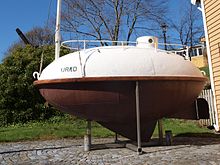Ole Brude
Ole Martin Brude (* around 1876 in Ålesund ; † November 3, 1949 in Seattle ) was a Norwegian seafarer who became famous around 1904 for an adventurous Atlantic crossing in a small sailing boat .
The boat
In 1898 the steamer Athalie got caught in a storm off Newfoundland . Brude served as a mate on this ship and was able to watch a wooden lifeboat being hit against the hull by a large wave and shattered. This event led the then 22-year-old to design a small, closed lifeboat on his return that should be made entirely of steel. Because of the shape, the nickname Brudeegget (the Brude egg) arose . Brude was convinced that a closed lifeboat is superior to open lifeboats in an emergency at sea .
The Atlantic crossing
In order to prove the seaworthiness of his boat, Ole Brude set off on July 27, 1904 with his three companions Iver Thoresen, Karl Thomas Hagevik Johansen and Lars Madsen in Ålesund to cross the Atlantic with his boat Uræd (Norwegian: fearless ). As water entered the boat, Brude turned around and started again on August 7, 1904 after the boat was repaired. The destination of the trip was the 1904 Olympic Games in St. Louis , where the French government and an American offered prize money of one million francs for a revolutionary new lifeboat. On November 15, the Uræd reached Petty Harbor on Newfoundland, making a timely arrival in St. Louis impossible. The rest of the journey lasted just under two months and ended on January 6, 1905 in Gloucester (Massachusetts) .
Boat building
Brother's business idea could not prevail in his time; only 22 copies of his boat were built. The closed boats (construction costs at that time: approx. 2000 crowns) were too expensive compared to conventional open wooden lifeboats (construction costs at that time: approx. 100 crowns). For example, he did not succeed in winning the White Star Line for his lifeboats after the sinking of the Titanic . One of his boats can be seen in a museum in Ålesund. Descendants from Brother's family now run the company Brude Safety , which produces ship safety technology. However , the company did not want the patent for Uræd .
Another résumé
After the failure of his boat business, Ole Brude emigrated to America . There he became a farmer and ran a sawmill. He died in Seattle in 1949 .
Today's lifeboats
Closed lifeboats have been mandatory on board Norwegian ships since the 1970s. These boats have been an international requirement on board cargo ships since the 1980s . The lifeboats departing from sloping ramps on oil rigs, but also from tankers, descend into the water shortly after take-off and therefore have to be completely closed.
literature
- Ebba D. Drolshagen: The egg that crossed the Atlantic in Mare No. 86, mareverlag, Hamburg, June / July 2011, pp. 76–81.
- Ole Ellefsen: Uræd. The Egg that crossed the Atlantic . NordvestTrykk, Ålesund 2005, ISBN 82-90151-12-8 , ( Ålesunds museums skrift 29).
Web links
| personal data | |
|---|---|
| SURNAME | Brude, Ole |
| ALTERNATIVE NAMES | Brude, Ole Martin (full name) |
| BRIEF DESCRIPTION | Norwegian navigator |
| DATE OF BIRTH | around 1876 |
| PLACE OF BIRTH | Ålesund |
| DATE OF DEATH | November 3, 1949 |
| Place of death | Seattle |

